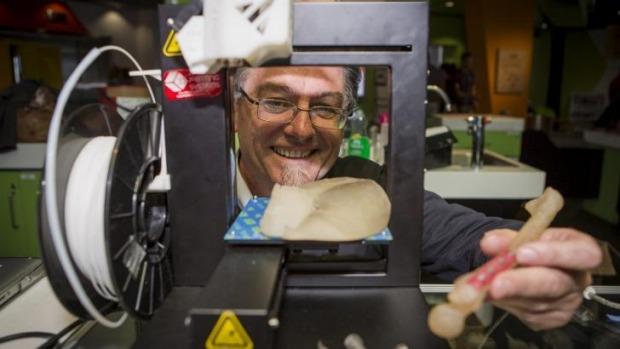Researchers Are 3D Printing Neural Cells Of the Brain, Unlocking New Secrets of the Complex Organ
 The 3D printing concept and all that has sprung forth from its technology is a result of some of the most creative and progressive minds of our time. Now, the efforts put forth by those very minds may actually result in giving us a deeper glimpse into the most complex parts of the brain itself, offering scientists a way to look at this most treasured anatomical part of our bodies.
The 3D printing concept and all that has sprung forth from its technology is a result of some of the most creative and progressive minds of our time. Now, the efforts put forth by those very minds may actually result in giving us a deeper glimpse into the most complex parts of the brain itself, offering scientists a way to look at this most treasured anatomical part of our bodies.
Revealing the deepest secrets of this tricky organ, the brain, has often led many to think we would be opening the truest Pandora’s box. While that’s a tremendous psychological conversation in itself, on a more optimistic and adventurous note, many others–and especially those in research–see unlocking the brain as unlocking the very key to the universe itself. We’re talking about being able to get a look at what top researchers refer to as bench-top brain tissue, with actual neurons lined up just as they belong, ready to fire away–but fabricated in 3D print.
Researchers at the ARC Centre of Excellence for Electromaterials Science (ACES) are the ones currently busy stirring up all this intellectual excitement as they’ve actually found a way to replicate and mimic brain tissue with 3D printed neural cells. While being able to 3D print these in physical form and even form cellular networks is a stunning achievement, what pulls the strings behind the scenes beforehand is 3D design. Without the two technologies working in tandem, the magic simply wouldn’t happen.
Digital design allows for the creation, assessment, and reworking of incredibly complex forms that can be made into 3D objects–and if they are not correct in prototype, the beauty is that the wheel does not have to be recreated. Only the digital file has to be tweaked, and another file sent to 3D print.
Considering these researchers are playing around with the idea of nearly 100 billion nerve cells, having a great deal of latitude in taking their ideas digital and being able to rework concepts over and over like a puzzle is crucial. The information that could be gleaned from benchtop brain tissue is something very highly desired.
Pharmaceutical companies are very motivated to find out the information held within the brain because obviously if they can find out exactly what makes the brain tick, they can make formulated drugs that not only work, but work better. While animal testing obviously yields results, they just aren’t precise enough in many cases.
Being able to take a look at different brain patterns and the organ overall, as well as precipitating and noting various actions, is obviously a process that would be valued at the highest level. Not only useful from the drug angle, being able to study and manipulate the brain so readily would offer much greater research regarding serious conditions such as schizophrenia and degenerative brain disease.
 So far, researchers have been able to create a customized 3D bio-ink which holds real carbohydrate materials and is processed in a cell culturing facility. Six layers deep, their 3D structure allows for cells not only to be spread out precisely and correctly, but they are well-protected and stay in place.
So far, researchers have been able to create a customized 3D bio-ink which holds real carbohydrate materials and is processed in a cell culturing facility. Six layers deep, their 3D structure allows for cells not only to be spread out precisely and correctly, but they are well-protected and stay in place.
“We are still a long way from printing a brain but the ability to arrange cells so as they form neuronal networks is a significant step forward,” said Professor Gordon Wallace, ACES Director, Australian Laureate Fellow and research author, with a paper on this subject just published in Biomaterials journal.
With so much intensive ground to cover, the key is simply in finding the beginning and building from there in trying to understand the relatively small organ that is so powerful and holds so many keys deep within.
“This study highlights the importance of integrating advances in 3D printing, with those in materials science, to realize a biological outcome,” Professor Wallace said. “This paves the way for the use of more sophisticated printers to create structures with much finer resolution.”
Subscribe to Our Email Newsletter
Stay up-to-date on all the latest news from the 3D printing industry and receive information and offers from third party vendors.
You May Also Like
3D Printing Financials: Velo3D Sees Better Q1 2024 After Difficult Last Quarter
Velo3D‘s (NYSE: VLD) first quarter of 2024 shows signs of recovery after a challenging end to 2023. The company is reaping the benefits of its strategic realignment and cost-reduction efforts....
Printing Money Episode 17: Recent 3D Printing Deals, with Alex Kingsbury
Printing Money is back with Episode 17! Our host, NewCap Partners‘ Danny Piper, is joined by Alex Kingsbury for this episode, so you can prepare yourself for smart coverage laced...
New Report: Semiconductor Industry to See $1.4B in 3D Printing Revenues by 2032
“The semiconductor sector has become the most strategically significant area of global industry.” Truer words are hard to come by when it comes to the modern world, and they are...
Velo3D Initiates Public Offering in a Bid to Strengthen Financial Foundations and Drive Future Growth
Velo3D (NYSE: VLD) has been among a number of publicly traded 3D printing firms that have attempted to weather the current macroeconomic climate. After posting a challenging financial report for 2023,...



































